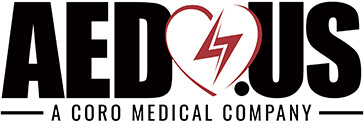Here at AED.US, we are committed to forging stronger links in the chain of survival. We talk constantly about the importance of empowering bystanders to initiate the rescue process. Now we’re going to make a case for why all employers should provide First Aid and CPR training to their employees.
First, and most importantly, CPR is a lifesaving skill. According to the US Occupational Safety and Health Administration, 10,000 SCAs happen in the workplace every year. An additional study by the American Heart Association found that only 50% of working Americans know where an AED is inside their workplace. With numbers like that, and a survivability rate that hovers around 10%, the importance of training employees in CPR becomes clear: it could be the difference between life or death in the event of an emergency.
Second, the skills that employees learn at an on-the-job CPR/First Aid training can be used anywhere. Sudden cardiac arrests and other medical emergencies can happen at any time, in any place. Training at work would promote education and safety in all facets of your employees’ lives. We know that within minutes of an SCA, the cessation of blood flow to vital organs can cause irreversible damage, so every second matters if we want to save more lives. Having knowledgeable and trained folks in our communities could decrease the response time and save more lives, and the workplace is an efficient way for American adults to receive this training.
Since we’re talking about business, the third benefit of training your employees in CPR and First Aid is that it could reduce workplace accidents. This type of training covers everything from SCAs to burns, bites, strains, sprains, cuts, and allergic reactions. When employees learn about how to respond to all of these situations, they also become more cognizant of workplace safety and personal health. Learning about the various risk factors for certain conditions may promote healthier lifestyles and safer workplace habits, reducing injuries and accidents that happen on the job. This also has economic benefits, since it could chip away at the $62 billion that American companies spend on workplace injuries every year.
Finally, providing an opportunity for your employees to receive CPR/First Aid training promotes a better workplace environment and makes employees feel valued. The entire team will feel safer knowing that everybody around them knows how to respond to emergencies, and this can help foster a culture where all employees look out for each other. Per a Business Insider report, we know that one of the biggest reasons for dissatisfaction at work is when employees don’t feel valued by their bosses. Employers who provide this type of training demonstrate that they value the health, wellbeing, and safety of each person who works there – and what better way to show that you care?
CPR and First Aid training at work is a no-brainer. It can save lives, reduce accidents, and promote a better working environment. Information about these trainings can be found on our website, and we are happy to help outfit your business with the AED that works best for you.
 Written by Blaire Czarniecki
Written by Blaire CzarnieckiCustomer Service Director
Blaire attended the University of Tennessee where she graduated with a Bachelor of Science in Human Ecology- Child and Family Studies. She has been in the Automated External Defibrillator (AED) industry for over eight years and is the Director of Customer Service for Coro Medical. Blaire is also an American Red Cross-certified CPR/AED/First Aid Instructor, highly trained by each manufacturer on their specific AEDs, and knowledgeable regarding ALL State AED regulations and legislation.“I know that every day I come to work, I am playing a part in saving someone’s life. I am passionate about these devices and am always looking for new and innovative ways to spread awareness and knowledge about Sudden Cardiac Arrest (SCA). I look forward to the day when everywhere I go, I will see an AED—when SCA will no longer take any lives.”
Last updated July 22nd, 2021.





